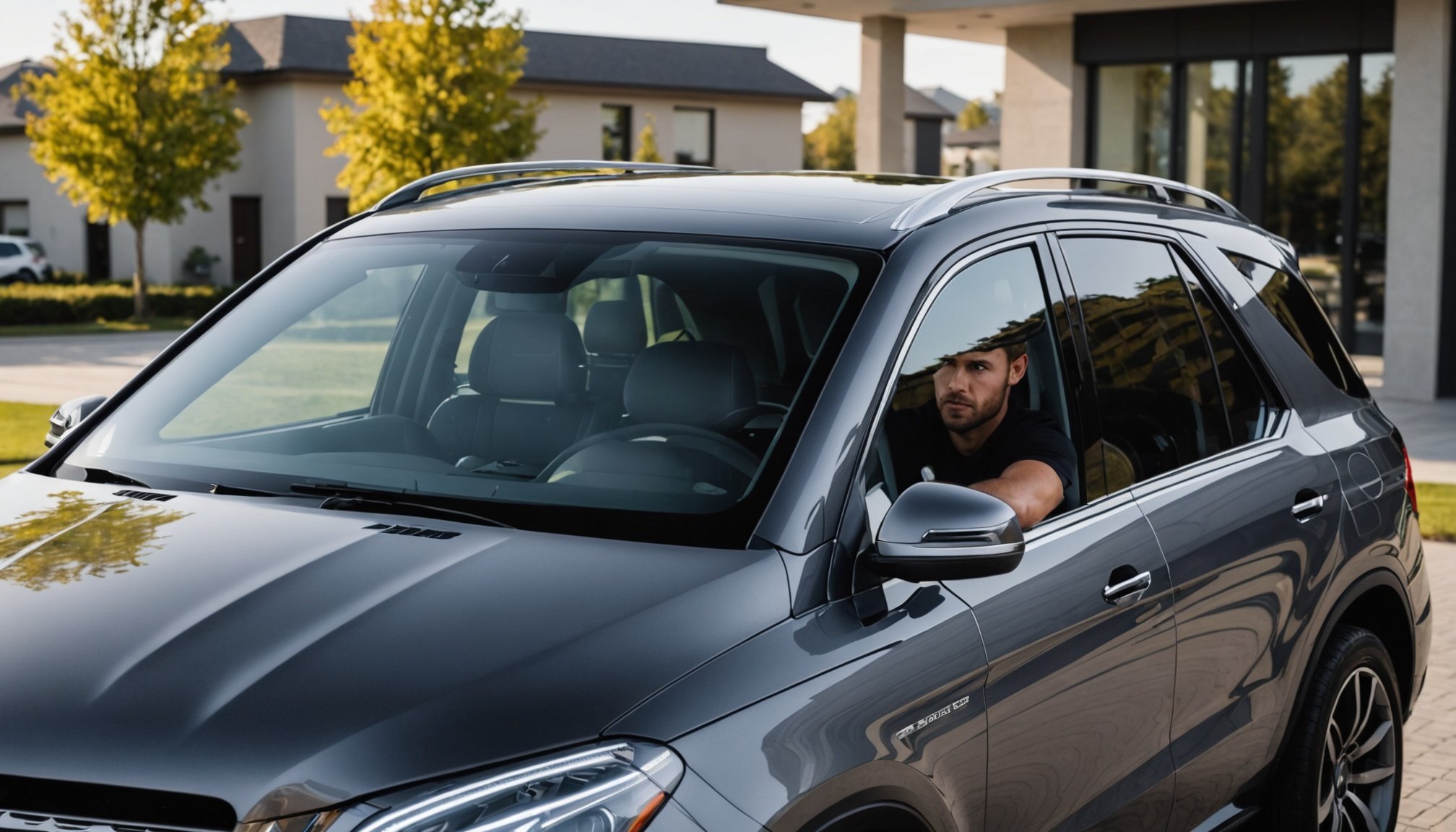Ultimate Guide to Applying Heat-Resistant Window Film in Your Mercedes-Benz GLE: Tips and Tricks for a Flawless Finish
When it comes to enhancing the comfort, safety, and aesthetic appeal of your Mercedes-Benz GLE, one of the most effective and popular modifications is the application of heat-resistant window film. This guide will walk you through the process, providing you with the tips, tricks, and essential information you need to achieve a flawless finish.
Understanding the Benefits of Window Film
Before diving into the application process, it’s crucial to understand why window film is a valuable investment for your vehicle.
Also read : Boosting Subaru BRZ Handling: The Impact of Installing a Strut Tower Brace
-
Heat Reduction: Heat-resistant window films, especially those with ceramic or metallic coatings, can significantly reduce the amount of heat that enters your car. This not only keeps your interior cooler but also reduces the strain on your air conditioning system, saving you fuel and enhancing your driving comfort[4].
-
UV Protection: These films block a substantial amount of UV radiation, protecting your skin from sun damage and preventing the interior of your car from fading or deteriorating over time.
Also read : Boost Your Ford Focus ST”s Performance: Does a Radiator Upgrade Enhance Cooling?
-
Privacy and Security: Window films can provide a level of privacy and security by making it difficult for outsiders to see inside your vehicle.
-
Energy Efficiency: By reducing the amount of heat that enters your car, you can lower your energy consumption, which is both eco-friendly and cost-effective.
Choosing the Right Window Film for Your Mercedes-Benz GLE
Selecting the right window film is critical for achieving the desired results. Here are some key factors to consider:
Types of Window Films
-
Ceramic Films: Known for their superior heat rejection and UV protection, ceramic films are a top choice. They are non-conductive, meaning they won’t interfere with your car’s electronics[4].
-
Metallic Films: These films are also effective at heat rejection but can sometimes interfere with electronic signals.
-
Dyed Films: These are more budget-friendly but offer less heat rejection compared to ceramic or metallic films.
Brand and Quality
- Look for reputable brands that offer high-quality films with good durability and warranty.
- Check reviews and ask for recommendations from auto enthusiasts or professionals.
Compliance with Local Laws
- Ensure the film you choose complies with local tint laws to avoid any legal issues.
Preparing Your Vehicle for Window Film Application
Before applying the window film, you need to prepare your vehicle to ensure a smooth and successful process.
Cleaning the Windows
- Use a high-quality glass cleaner and a microfiber cloth to clean the windows thoroughly. Remove any stickers, decals, or existing films.
- Use a razor blade to remove any stubborn residue, but be careful not to scratch the glass.
Removing Trim and Molding
- For a seamless application, you may need to remove some trim and molding around the windows. Use a trim removal tool to avoid damaging the parts.
Ensuring the Right Environment
- Apply the film in a clean, dust-free environment. Avoid applying film in direct sunlight or extreme temperatures.
Step-by-Step Guide to Applying Window Film
Here’s a detailed step-by-step guide to help you apply the window film correctly:
Materials Needed
- Window film
- Application fluid
- Squeegee
- Cutting tool (e.g., razor blade or film cutter)
- Measuring tape
- Trim removal tool (if necessary)
Measuring and Cutting the Film
- Measure each window carefully to ensure you cut the film to the exact size.
- Use a cutting tool to cut the film, leaving a little extra around the edges.
Applying the Film
- Spray the Window: Spray the application fluid onto the window to create a slick surface.
- Apply the Film: Place the film onto the window, starting from the center and working your way outwards.
- Remove Air Bubbles: Use the squeegee to remove any air bubbles, working from the center outwards.
- Trim the Edges: Use a razor blade to trim the excess film around the edges.
Tips for a Flawless Finish
- Use the Right Tools: Invest in a good quality squeegee and cutting tool to avoid scratches and bubbles.
- Work Slowly: Take your time to ensure each step is done correctly.
- Avoid Stretching the Film: Apply the film smoothly without stretching it, as this can cause wrinkles and bubbles.
Common Mistakes to Avoid
Here are some common mistakes to watch out for when applying window film:
Incorrect Measurement
- Ensure you measure the windows accurately to avoid cutting the film too small or too large.
Insufficient Cleaning
- Make sure the windows are completely clean and free of residue to ensure a smooth application.
Applying in Wrong Conditions
- Avoid applying the film in direct sunlight, high winds, or extreme temperatures.
Additional Protection: Paint Protection Film (PPF) and Ceramic Coating
In addition to window film, you might consider other protective measures for your Mercedes-Benz GLE.
Paint Protection Film (PPF)
- Clear Bra: A clear protective film applied to high-impact areas like the front bumper, hood, and fenders to protect against rock chips and scratches.
- Benefits: PPF is virtually invisible and provides long-lasting protection against everyday wear and tear.
Ceramic Coating
- Ceramic Coatings: A chemical coating applied to the paint to create a protective barrier against the elements.
- Benefits: Ceramic coatings offer superior protection against UV damage, water spots, and minor scratches. They also make cleaning easier and maintain the glossy finish of your car’s paint.
Table: Comparison of Window Film Types
| Type of Film | Heat Rejection | UV Protection | Privacy | Cost | Durability |
|---|---|---|---|---|---|
| Ceramic Films | High | High | Medium | High | High |
| Metallic Films | High | High | High | Medium | Medium |
| Dyed Films | Low | Medium | Low | Low | Low |
Practical Insights and Actionable Advice
Here are some practical tips and advice to keep in mind:
Maintenance
- Regularly clean the windows with a mild soap solution to maintain the film’s effectiveness.
- Avoid using abrasive materials that could scratch the film.
Professional Help
- If you’re not comfortable with the application process, consider hiring a professional. They have the tools and experience to ensure a flawless finish.
Warranty
- Check the warranty offered by the manufacturer and ensure it covers any defects or issues that may arise.
Quotes from Experts
-
“Applying window film is a straightforward process, but it requires patience and attention to detail. Taking your time and using the right tools can make all the difference,” says Jon Barnes, an auto detailing expert from Cedar Park.
-
“Ceramic films are my go-to choice for clients who want superior heat rejection and UV protection. They offer a level of performance that other films can’t match,” notes a technician from Blue Ocean Auto Spa.
Applying heat-resistant window film to your Mercedes-Benz GLE is a great way to enhance your driving experience, protect your vehicle, and add a touch of style. By following the steps outlined in this guide, choosing the right film, and avoiding common mistakes, you can achieve a flawless finish that will last for years to come. Whether you’re looking to reduce heat, protect against UV rays, or simply add some privacy, the right window film can make a significant difference in your vehicle’s comfort and protection.
Remember, if you’re unsure about any part of the process, it’s always best to consult a professional to ensure the job is done correctly. With the right tools, a bit of patience, and some practice, you’ll be enjoying the benefits of your new window film in no time.






